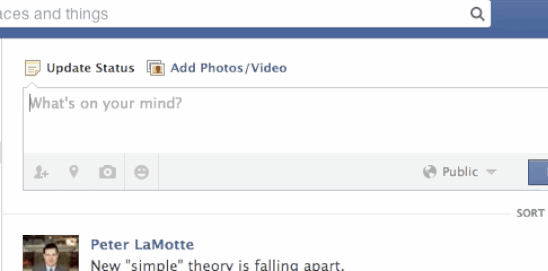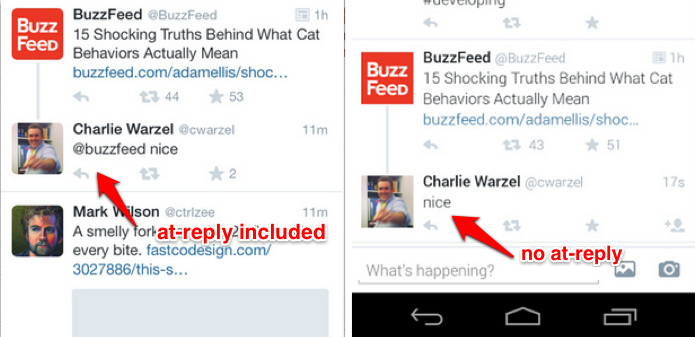What will Twitter look like in a year? Two years? A lot less like itself.
At least that's the impression Vivian Schiller, head of news at Twitter, gave addressing the crowd two days ago at the Newspaper Association of America's mediaXchange conference in Denver. During her talk, Schiller called at-replies and hashtags "arcane" and hinted that Twitter might soon move them into the background of the service.
Twitter's @vivian calls hashtags & @s "arcane": "We are working on moving the scaffolding of twitter into the background" @cwarzel
When asked about the comments, Twitter replied that Schiller was echoing a similar sentiment that the company's CEO, Dick Costolo, addressed in a recent earnings call:
By bringing the content of Twitter forward and pushing the scaffolding of the language of Twitter to the background, we can increase high-quality interactions and make it more likely that new or casual users will find this service as indispensable as our existing core users do. And we took initial steps in that direction with the introduction of media forward timelines and in-line social actions in October, and we're already starting to see early signs that those initiatives are working well.
Unlike Schiller's, Costolo's statement makes no specific mention of hashtags and at-replies, suggesting that Schiller may have accidentally hinted at specific targets for upgrade. While it's not immediately clear how this disappearance would work, it's possible that at-replies will be auto-replaced by formal Twitter names, like they are on Facebook.

It wouldn't be the first time Twitter phased out one of its vestigial appendages. Twitter's all but killed the original incarnation of the retweet or, as Twitter obsessives have now come to know it, the "manual retweet." In its earlier days, the retweet was a user-generated feature; users had to physically add the "RT" shorthand to a tweet to share it with their followers. It was primitive and confusing to the uninitiated.

In 2009, Twitter formalized the feature by baking the retweet function into the platform. This is what its looks like now:

Formalized retweets were less cumbersome, allowed information to spread quicker and with better attribution, and, perhaps most importantly, removed a thin layer of weird jargon for new users to get used to.
Which brings us back to Schiller's hint.
Twitter, at its core, is a strange service; its foundational feature is an arbitrary 140-character limit. This was surely vital to Twitter's success, but it's also the source of all its "cryptic and opaque" language — a rough collection of shorthands and initialisms (RT, MT, #FF) and hacks, born out of user quirks and necessary behaviors. Ask a longtime user to tell you about their first experience with Twitter and they'll probably lead with some variation of, "Somebody showed me how to use it..." The idea being that, unlike most social networks, you don't usually just discover and use Twitter, you are taught, or at least climb a fairly steep learning curve.
Unlike Facebook, which asks for obvious information and then uses it to make obvious connections, Twitter demands significant time and energy from the user up front. It doesn't fully succeed in telling you how to use the service; it fails, utterly, to tell why you should. Those willing to stick around long enough are rewarded with a peculiar sense of something that could best be described as belonging.
But that hard-earned belonging is less important now to post-IPO Twitter. The service has a very real growth problem. Users sign up, but they don't stick around. There's more than one reason for this, but the problem, at least in Costolo's mind, lies somewhere inside the "scaffolding." (Costolo used the exact same language in a CNBC interview the day of Twitter's IPO.)
Twitter's very public evolution from a text-based update service to a multimedia stream has been well-documented, and distinctly directional: Each change inches it toward becoming more accessible and less strange. If at-replies and hashtags recede into the background, Twitter will likely become faster, better optimized for tweets to move quickly and gather interactions. It will also look a lot more like its competitors.
When Twitter announced it would be formally incorporating retweets in 2009, Biz Stone cited the user-generated feature as "a great example of Twitter teaching us what it wants to be." But that was a very different Twitter. Back then, the scaffolding was out in the open, inviting users to climb and play and fiddle and destroy — to make it their own. Today, though, Twitter is a company with a good idea of what it is, and an even better idea of what it wants to be.
And don't discount the possibility that Twitter is still refining its metaphor. Real scaffolding doesn't "move into the background." It's temporary. It disappears — it is removed — to reveal the completed structure.
Updated — March 19, 1:51 p.m. ET: Schiller notes that Twitter is not getting rid of at-replies and retweets altogether. When BuzzFeed asked if there was any chance that at-replies and hashtags could become more formalized/pushed into background like retweets, Schiller remained vague:
@cwarzel @stkonrath There's a lot of creative thinking going on around how to make Twitter more and more intuitive. Watch this space.
Update 2 — March 19, 3:00 p.m. ET: Twitter appears to already be phasing out at-replies in its Android alpha test group app. BuzzFeed received a screenshot from a user in this group, which shows the app has eliminated user handles in replies to tweets, connecting them instead with just a conversation line. This is a test version, so it is still subject to change when released to the public, but it's proof that Twitter is formally testing phasing out at-replies.

